The first application of the fluid, which has the ability to be mixed at different densities using freshwater or field water, proved successful.
Kirk M. Bartko, Tushar S. Mukherjee and Carlos I. Arocha, Saudi Aramco; Leopoldo Sierra, John Terracina and Paul Lord, Halliburton
As Saudi Arabia increases its domestic demand for natural gas, ongoing reservoir targets are moving increasingly to more challenging reservoirs that exhibit low permeability (less than 0.01 mD). Reservoir pressure ranges can be either low or extremely high (11,000–13,000 psi), and the high temperature makes obtaining reservoir data difficult due to tool limitations.
During the first quarter of 2008, Saudi Aramco was challenged to perform a proppant fracture stimulation in a deep tight gas onshore sandstone formation where the temperature and stress conditions (375°F and 1.1 psi/ft at 20,000 ft) exceeded the working pressure capability of the available equipment and the existing fracturing fluid application limits, Fig. 1.
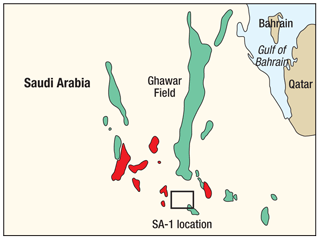 |
|
Fig. 1. The exploration area was located 100 km south of Ghawar Field, near existing oil and gas fields.
|
|
Knowing that 20,000-psi fracturing equipment was not available in the area, an extensive laboratory evaluation was carried out to design a new high-density fracturing fluid. The new fluid system was successfully mixed and pumped in the field, enabling the treatment of the well (through lower surface treating pressure) with conventional 15,000-psi equipment, with lower horsepower requirements and a safer work environment than would have been possible with the 20,000-psi equipment.
GEOLOGY
A Sularian-age rock and a member of the Qalibah Formation, the Qusaiba Formation is well known for its organic-rich, hot shales. The Qusaiba member also contains sand-prone intervals, which are the target for exploration potential. In general, the porosity in Qusaiba is largely reduced by cementation, but the quality of the reservoir was improved by the existence of microfractures.
Two particular formations that have recently received attention are the Sarah and Mid-Qusaiba Formations. These two reservoirs have been penetrated more than 25 times in Ghawar and the western Rub Al Khali areas by Saudi Aramco and other oil companies. Reservoir quality is typically moderate to poor (5–15% porosity); natural fractures are thought to significantly enhance deliverability in wells. Recently, hydraulic fracturing was included in the testing of these formations, which resulted in short-term rates of 3–5 MMcfd.
Hydraulic fracturing of these formations is increasingly challenging due to mechanical limitations on the completion assembly and surface equipment. Maximum surface pressure limitations of 15,000 psi with a maximum bottomhole pressure limitation required the use of 12.3-lb/gal sodium bromide (NaBr) brine. Heavy brines had been successful in deep Gulf of Mexico fracture packing; however, they had never been applied to a tight gas reservoir. Development of this fluid was targeted to local material resources, fluid stability at 375°F, proppant transport capability and minimal formation damage.
EXPERIMENTAL EVALUATION OF A NEW FRACTURING FLUID
High-density NaBr brine, gelled and crosslinked with borate-type systems, has been used before in offshore environments for fracture stimulations at temperature conditions below 300°F. For temperature conditions above 300°F, such as the tight gas reservoir of this case study where the temperature is in the range of 350–375°F, this fluid is not stable, making it necessary to develop and evaluate a new fluid system for the high-temperature conditions.
The quality and stability of the NaBr brines, gelled and crosslinked with borates, are highly dependent on the quality of the salt and water used to prepare the brine base. Strict quality control of the salt and water to prepare the brine solution and the mixing process is necessary to assure the quality of the fluid.
In the new fluid system, the base fluid is 12.3-lb/gal NaBr brine, gelled with a carboxymethyl-hydroxypropyl guar gelling agent. An acidic buffer is added after the gelling agent to aid gel hydration. A non-ionic surfactant is added to the base gel to enhance fluid recovery. Gel stabilizer is added to the base gel to achieve high-temperature stability in the fracture. A high-pH buffer is added to the base gel after the gel is fully hydrated. A delayed zirconium crosslinker is added to the fluid as the fluid is pumped downhole. If necessary, a crosslink delay agent is added to the fluid to further delay crosslink time.
Extensive laboratory testing indicated that the final gel quality and stability of the new fluid system depends on the quality and source of the NaBr salt. For this application, main suppliers of salts in the Americas, Europe, Asia and the local region were evaluated. The NaBr brine supplied in the region was selected. For all the tests, the regional brine produced a good-quality fluid using either the concentrated version (spike) or the diluted version. Another advantage of the regional brine was its ability to accept fresh or field water for dilution as stimulation conditions required. The low-density version of the new fluid system is shown in Fig. 2; field water was used to drop the brine spike density to 11.5 lb/gal.
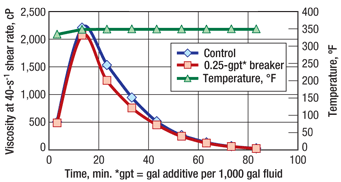 |
|
Fig. 2. Low-density fluid viscosity at 350°F and 11.5 lb/gal.
|
|
Test results showed the viscosity of the new system at 350°F (Fig. 3), 325°F and 315°F. Figure 4 shows the results of a crosslink time test, indicating that the crosslink time delay agent increases the temperature at which the fluid begins to crosslink.
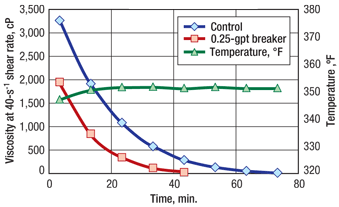 |
|
Fig. 3. High-density fluid viscosity at 350°F and 12.3 lb/gal.
|
|
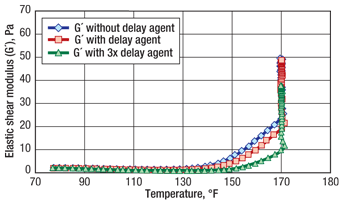 |
|
Fig. 4. Effect of crosslink delay agent on temperature fluid crosslinks.
|
|
FIELD APPLICATION
An exploratory well completed with a 4½-in. monobore with a 3.92-in. internal diameter was selected for the field application. The SA-1 well was drilled and completed during the first quarter of 2008. The monobore completion provided the opportunity to perform all four test intervals using rigless operation techniques, including wireline perforating and coiled tubing intervention operations.
The Mid-Qusaiba was a secondary target, and three tests were performed to identify gas productivity. The lower and middle tests proved to be tight, with no conclusive connectivity to the reservoir because breakdown pressure was never achieved due to pressure limitations. The final test was the upper Mid-Qusaiba, Fig. 5. The perforated interval was 100 ft, shot at six shots per foot at 120° phasing. Oriented perforations were considered, since the fracture orientation was known; however, the bottomhole temperature of 355°F prevented the use of a gyro.
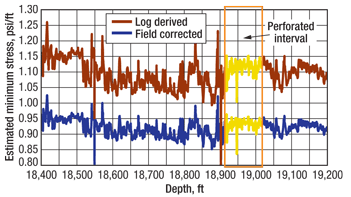 |
|
Fig. 5. Log-derived and field-corrected stress profiles.
|
|
The stress profile implied that the perforated interval had an average stress value of 1.1 psi/ft versus the predicted 0.95 psi/ft. Considering the normal 6% potassium chloride (KCI) crosslinked fracturing fluid and the specific completion string (4½-in. monobore completion with 3.92-in. ID) used in Saudi Arabia to stimulate a normally stressed or shallow formation, the expected wellhead pressure would be higher than 13,000 psi. In the same wellhead configuration, use of 12.3-lb/gal NaBr crosslinked fluid would bring the wellhead treatment pressure to 9,500 psi at 10 bbl/min. and to 11,500 psi at 30 bbl/min. The comparative wellhead treatment pressure for crosslinked fluids mixed with 6% KCl and 12.3-lb/gal NaBr is shown in Fig. 6.
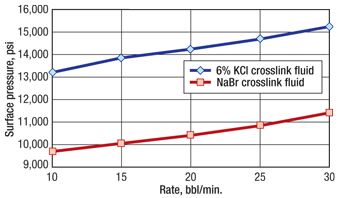 |
|
Fig. 6. Comparative wellhead treatment pressure for crosslinked fluids mixed with 6% KCl and 12.3-lb/gal NaBr.
|
|
In Saudi Arabia, and in the entire region, there does not exist any 20,000-psi fracturing equipment with which one could use the conventional 6% KCl borate crosslinked fluid, so it was necessary to use the new high-density crosslinked fracturing fluid. Using the completion scheme and the stress profile, a fracture stimulation was designed using the new 12.3-lb/gal NaBr crosslinked gel for high-temperature applications. Proper stimulation of the Upper Rhuddanian-age shale required the following steps:
1. Wellbore completion fluid displacement with a clean 12.3-lb/gal NaBr brine mixed with recovery enhancement chemicals using coiled tubing
2. Formation breakdown and fall-off test to determine the reservoir properties
3. Clean 12.3-lb/gal brine displacement with a 12.3-lb/gal linear gel prepared with 20-lb/1,000-gal gelling agent and chemicals
4. Step-rate and step-down test with 12.3-lb/gal linear gel
5. Minifrac using the new 12.3-lb/gal crosslinked gel prepared with 50-lb/1,000-gal gelling agent
6. Temperature log to determine the fracture containment of vertical growth
7. Main proppant fracture stage using the new fluid and 30/50-mesh high-strength proppant.
Table 1 summarizes the proposed fracture stimulation schedule, where it was planned to place 149,500 lb of 30/50 proppant with 71,500 gal of the new high-temperature crosslinked 12.3-lb/gal fracturing fluid. Analysis of the step-rate and step-down stages permitted calculation of the following main parameters:
• Reservoir permeability in the range of 0.0247–0.1 mD
• Fracture extension pressure of 9,180 psi at wellhead or 20,965 psi downhole
• Sixteen connected perforations to the fracture from a total of 600 perforations of 0.28-in. entry hole.
| TABLE 1. Proposed fracture stimulation schedule |
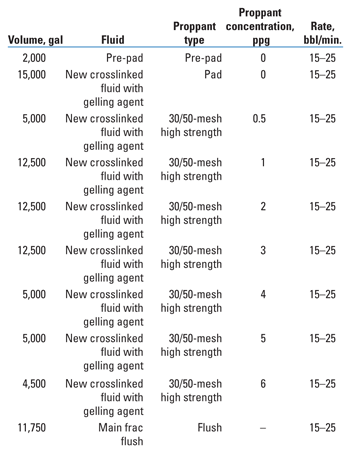 |
The minifrac stage of the stimulation was not analyzed because of injection rate variation during this period. The rate variation of filling the wellbore with the new crosslinked fluid made it necessary to check the wellhead and bottomhole pressure variation against the injection rate. Figure 7 shows the temperature log information on the minifrac, indicating that the fracture was contained in the perforated interval and that there was no preferential upward fracture growth. It was critical to ensure fracture containment within the perforated interval prior to performing the main fracture stimulation.
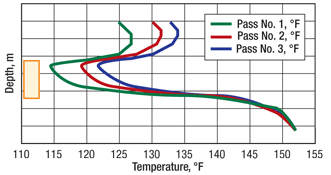 |
|
Fig. 7. Temperature log after the minifrac.
|
|
The stimulation job in the Upper Rhuddanian was performed at an average rate of 16.4 bbl/min. The treatment rate was limited at the referenced rate to not exceed the pressure limitations of the completion string at downhole conditions (22,000 psi). Due to the long transit time of the fluid inside the completion string, there was a concern about early crosslinking of the gel into the first part of the 4½-in. tubing. The smooth pressure behavior along the entire pumping time corroborated the observation that the fluid properties were stable with and without adding proppant. The lower injection rate was not a limitation for the treatment.
The job was performed as per the design, placing into the fracture 155,800 lb of 30/50 proppant with 78,150 gal of the new 12.3-lb/gal crosslinked fluid system for high-temperature environments.
CONCLUSION
Results of the tests and the field application confirm that the new high-density fracturing fluid is stable at temperatures above 300°F and that the crosslinking time can be delayed. When using an adequate NaBr source, the fluid system can be mixed at different densities using freshwater or field water without affecting the quality. Smooth pressure behavior during the entire treatment corroborates that good quality gel was maintained at surface and downhole. Performed at a lower rate, the field application demonstrates that the fluid possesses exceptional proppant transport capabilities. 
|
THE AUTHORS
|
 |
Kirk M. Bartko is a Stimulation Consultant with Saudi Aramco’s Petroleum Engineering Support Division. He holds a BS in petroleum engineering from the University of Wyoming in Laramie, Wyo. Mr. Bartko joined Saudi Aramco in 2000 and develops and supports new stimulation and completion technologies across Saudi Arabia. He is now supporting the South Ghawar Gas Development Project. Mr. Bartko’s experience also includes 19 years with ARCO.
|
|
| |
Tushar S. Mukherjee works as a Unit Head of the Onshore Deep Gas Exploratory Wells Engineering Unit in Saudi Aramco. He received a BS degree in mechanical engineering from the University of Allahabad in India and an MS degree in management from the University of Mumbai.
|
|
| |
Carlos I. Arocha is a Senior Drilling Engineer with Saudi Aramco and has more than 20 years of diverse experience in drilling and workover completions of HPHT exploration and development wells. He received his BS degree in petroleum engineering from the Industrial University of Santander in Bucaramanga, Colombia, and a management specialization from the National Pedagogic and Technological University of Colombia in Tunja, Colombia.
|
|
| |
Leopoldo Sierra is a Petrochemical Engineer with more than 30 years of experience with Halliburton Energy Services. His experience includes stimulation and reservoir engineering services in Peru, Venezuela, the US and Saudi Arabia. Mr. Sierra graduated from the National University of Engineering (UNI) in Lima, Peru.
|
|
| |
John Terracina, formerly of Halliburton, received his BS degree in chemistry from Northeast Louisiana University in Monroe, La.
|
|
| |
Paul Lord is the Sand Control Team Lead for Halliburton’s Technology Center in Duncan, Okla. He joined Halliburton in 1997 after receiving his BS degree in chemistry and his MS degree in engineering technology management from Oklahoma State University.
|
|











